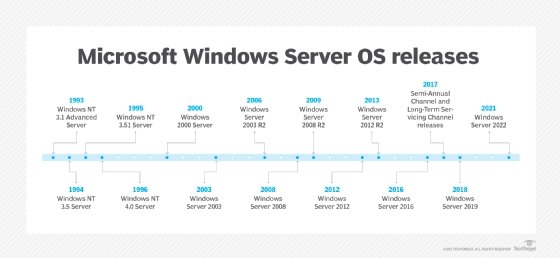Windows NT
What is Windows NT?
Windows NT was a family of operating systems (OS) developed by Microsoft for personal computers and servers. When it was first released in 1993, the OS featured capabilities that were considered advanced for that era, including multiprocessing, support for multiple users and processor independence.
Windows NT may originally have stood for New Technology, although Microsoft hasn't confirmed that. The first version of the OS was released as Windows NT 3.1. It was intended to complement the consumer versions of the MS-DOS-based Windows OS that existed at the time, including Windows 1.0 to Windows 3.1x. The technology of Windows NT was the basis for the Windows 2000 OS that was released in 2000.
Windows NT offered both software and hardware portability, and multiple versions were released for various processor architectures, including MIPS, IA-32, ARM, PowerPC and X86-64. Furthermore, Microsoft created a common code base with a hardware abstraction layer for each platform. The OS also supported multiple application program interface (API) personalities like Windows API, POSIX API and OS/2 API to ensure extensive software compatibility.
Windows NT Workstation vs. Windows NT Server
The Windows NT brand consisted of two products: Microsoft NT Workstation and Microsoft NT Server. The versions were identical in system structure but modified to suit different application environments.
Windows NT Workstation was suitable for interactive desktop environments and designed for users who needed fast performance and a fail-safe system. It had the same desktop user interface as Windows 95. The OS was available in both 16- and 32-bit versions and could be connected to up to 10 clients as a network server. However, the OS supported a maximum of two processors and only one remote client access, along with limited network service functions.
Windows NT Server provided an easy-to-manage and responsive enterprise network environment. It was meant for business machines that provided services for network-attached computers and for Windows systems that would serve web pages (together with an Internet server such as Microsoft's Internet Information Server, or IIS).
NT Server was Microsoft's first purely 32-bit OS and included more advanced functions than NT Workstation. For example, NT Server 4.02 supported up to 32 processors and up to 256 remote client accesses. As a network server, it could connect to clients without restrictions to complete heavy network-related tasks. It also came with built-in disk fault tolerance and support for Macintosh file and print.

Key features of Windows NT
Windows NT was the first 32-bit version of Windows. Microsoft's previous consumer-oriented operating systems like Windows 3.1x and Windows 9x, were 16-bit/32-bit hybrids. Its kernel could stop any task and start others without inputs from the application programmer. The NT OS also managed virtual memory and supported networking and multiple remote terminals.
Windows NT's NTFS file system – which is required by many SQL Server and IIS features – included many multiuser and security features. Its long file names and large disk addressing capability were comparable to the DOS-based FAT system. Windows NT also included several features that were not available with earlier versions of Windows and other OSes:
- Support for multiple CPU systems with symmetric multiprocessing technology (SMP).
- Compatible with many hardware platforms, including CISC and RISC.
- Enabled pre-emptive Multitasking and threading operations.
- Support for multiple protocols, including TCP/IP, NetBEUI, Data Link Control, AppleTalk and NWLink.
Windows NT also included multi-boot capability that let it coexist with other operating systems.

Evolution of Windows NT
Development on Windows NT started in 1988, although it wasn't released until 1993. The OS was originally known as OS/2 3.0 and was being developed jointly by Microsoft and IBM. The collaboration eventually fell apart when Microsoft unilaterally decided to change the primary API for the unreleased NT OS/2 from an extended OS/2 API to an extended Windows API.
Following the separation, IBM continued developing OS/2 while Microsoft worked on the now-renamed Windows NT OS. From the beginning, Windows NT was designed to run on multiple instruction set architectures and support multiple hardware platforms in each architecture. The design also included a kernel mode module that hid the platform dependencies from the rest of the system. The API sets in Windows NT were also implemented as subsystems atop the native API, allowing for the adoption of the Windows API into the Win32 subsystem. The OS was also the first to use unicode internally. For all these and other reasons, Windows NT became far more successful than IBM's OS/2.
Drawbacks of Windows NT
For over a decade, Windows NT was one of Microsoft's most popular operating systems due to its high performance, strong application service capability and support for many software applications and processors. It could also run SQL Server databases and IIS web servers, unlike other Windows OSes of the time. Just a few years after release, Windows NT became a major platform for PC-based games and a base technology for workstations.
One of its drawbacks was that it was generally not compatible with UNIX in terms of programming APIs except in areas like Windows Sockets. However, NT was comparable to UNIX in terms of its features and capabilities.
Another drawback of NT was that it did not run well on systems with slower processors and limited memory. It also created performance issues with applications like Microsoft Office, which were sensitive to data structure alignment issues on RISC processors.








